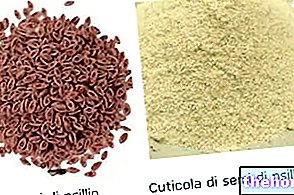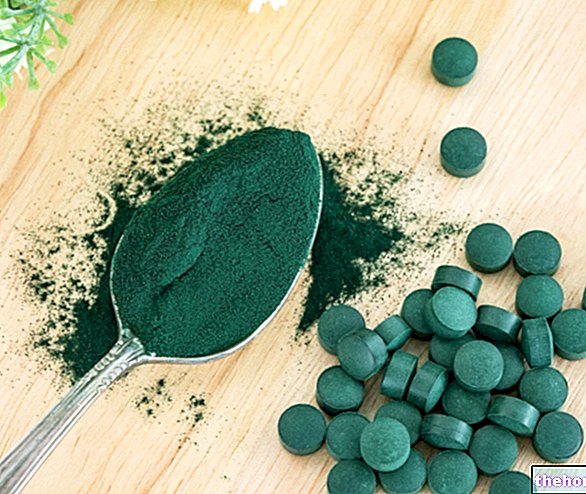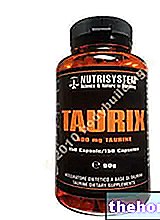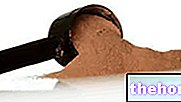What is Pollen
Pollen is a fine, sticky dust that forms the fertilizing matter of flowers.
For this reason it is a characteristic element, a sort of different genetic imprint for each type of flower.

Since bees, during their normal foraging activity, collect pollen from a great variety of flowers, it is not possible to know a priori the exact chemical composition; the data reported in this article are therefore indicative.
Precisely by virtue of its nutritional completeness, bee pollen is used as a nutritional supplement.
Indications
Why is bee pollen used? What is it used for?
Pollen is a real concentrate of proteins, present at 30% and made up of all eight essential amino acids for man.
In addition to these, twenty of the twenty-two alpha-aminoocides of food interest are present, even in free form.
Each pollen grain contains about 35% of carbohydrates (in particular glucose and fructose) which, together with the abundant content of trace elements and vitamins, make it a complement with marked energetic and revitalizing properties.
The fatty substances, on the other hand, are present in an average percentage of 5% and being mainly made up of unsaturated fatty acids, they are particularly useful for the well-being of the organism.
The vitamin content is particularly high, so much so that a single tablespoon of pollen alone is able to cover the daily requirement of many vitamins; the only ones absent are vitamin F (essential fatty acids) and B4 (adenine), among other things not really considered vitamins.
Mineral salts (phosphorus, potassium, magnesium, calcium, silicon, manganese, copper, iron, sodium, chromium and zinc) are also well represented.
The completeness and complexity of its components, together with the popular medical tradition, make pollen a dietary supplement useful in the treatment and prevention of numerous conditions, pathological and not (anemia, arteriosclerosis, asthenia, capillary fragility, colitis, depression, diabetes, weight loss, eczema, flu, tired eyes, prostatitis, rheumatism, constipation and varicose veins). Its adaptogenic virtues make it useful for improving the adaptation and response of the organism to stressful events of various kinds.
The use of pollen is also widespread in the sports field, where its richness in minerals, vitamins and amino acids is appreciated.
Although many people, after having tried it, confirm the curative and revitalizing properties of pollen, there is no certain evidence that confirms its effectiveness in the sports field, much less in the therapeutic one. For what has been said so far, pollen can still be reasonably considered. a valid and complete natural alternative to synthetic multivitamin and multimineral supplements.
Properties and Effectiveness
What benefits has bee pollen shown during the studies?
As mentioned, most of the studies on the benefits of bee pollen have been conducted on experimental and animal models.
In the latter, the "regular use of bee pollen" would have guaranteed a clear improvement in the functionality of the immune system, an improvement in laboratory blood chemistry parameters and in general an important improvement in the quality of life.
However, there is a lack of noteworthy clinical evidence.
Dosage and method of use
How to use bee pollen
Fasting is the most suitable time to consume pollen, which can be taken, for example, before breakfast or between meals.
The doses classically used vary according to the product, ranging from 1 gram to 10 grams per day.

The minimum duration of each treatment varies from one to three months: the longer it is continued, the more the dosage can be reduced to a maintenance value.
Pollen can be marketed in pearls, tablets or, more simply, in the natural state in the form of many small "balls" packaged directly by bees. As mentioned at the beginning of the article, the more the colors are varied (from ivory white to gray, to yellow, to greenish, to red, to brown, up to black), the more the varieties of pollen consumed and their effects will be expanded.
Side effects
The incidence of side effects linked to the consumption of bee pollen tends to increase significantly in allergic subjects.
In these patients it was frequently observed the appearance of itching, rhinitis, conjunctivitis, bronchospasm and in only two cases hepatotoxicity.
Hypereosinophilia and neurological symptoms, on the other hand, were decidedly rarer.
Contraindications
When should bee pollen not be used?
Pollen is contraindicated for allergic subjects, to which it could cause severe problems even if ingested without being inhaled (for example in the form of pearls); if its origin is not controlled, as often happens for non-EU products, the risk of contamination with pesticides must also be assessed.
The consumption of pollen can have laxative effects and, thanks to its mild stimulatory, but not irritating, effect on the lazy intestine, it can help to fight constipation.
The use of pollen as a supplement is also contraindicated in children, during pregnancy, and in the subsequent period of breastfeeding.
Pharmacological interactions
What drugs or foods can modify the effect of bee pollen?
No noteworthy drug interactions are currently known.
Select plant Fir Acacia Acerola Sorrel Yarrow Yarrow Yarrow Aconito Adatoda Garlic Agnocasto Agrimonia Alchemilla Alkekengi Aloe Altea Witch Hazel Ammi or Visnaga Pineapple Andrographis Anemone Pulsatilla Angelica Anise Star Anise Japanese Star Anise Bitter Orange Bitter Areca Arnica Harpagophytum Arpagophyte Artemisia Asteragus Basil Asparagus Asparagus Peruvian Asparagus Asparagus Asparagus Hawthorn Boldo Borage Shepherd's Purse Boswellia Bucco Butea superba Cocoa Coffee Cajeput Calamus Calamus Marigold Camedrio Chamomile Roman Chamomile Camphor Cinnamon Ceylon Maidenhair Capuchin Artichoke Cardamom Cardiac Thistle Asian Thistle Carvi Cascara Cassia Catecu Catha Cabbage Celandine Chicory Centaurea Cinnamon Cypress Celandine Chives Cypress Coca Cola Colchico Combreto Condurango Comfrey Coriander Cranberry Barberry American Chrysanthemum Cumin Turmeric Damiana Digital Dioscorea Drosera Dulcamara Dunalilella Echinacea Eder a Ephedra Elenio Eleutherococcus Helichrysum Evening primrose Horsetail Alfalfa Erica Euphrasia Erisimo Escolzia Eucalyptus Farfara Farfaraccio Calabar bean Fenugreek Fennel Phytolacca Frangola Ash Fumaria Japanese Mushrooms Galega Ganoderma lucidum Garcinia Cambogia Mulberry Gentian Broom Ginkgo Ginkgo Guipana Guipana Gynestra Ginkgo Hibelia Gymnasium Hibiscus Guarulp St. John's Wort Horse Chestnut Ispaghul Hyssop Jaborandi Kava kava Konjac Laminaria Cherry Laurel Lavender Lemongrass Lespedeza Lovage Icelandic Lichen Lemon Flax Lippia Licorice Lobelia Hops Maca Marjoram Maize Mallow Manna Marrubio Marrubio d "water Matè Melaleuca Meliloto American Lemon balm Myrtle Myrama Walnut Nutmeg Walnut vomica Olive tree Meadowsweet Ononide Opuntia Oregano Orthosiphon Nettle Poppy Papaya Parietaria Feverfew Passiflora Chilli Perilla Periwinkle Phyllanthus Plantain Picrorhiza Pilosella Pino Pisci dia Podofillo Polygala Grapefruit Parsley Psyllium Pueraria mirifica Butcher's broom Pygeum Quassia Oak Rhubarb Ratania Rauwolfia currant Castor bean Rhodiola Rosehip Rosemary Rue Willow Sarsaparilla Sage Elderberry Sassafras Sedum Ergot Senna Serenoa Repens Soybean Solidago Tansy Taraxus Tamarind Tamarind Tamarind Tamarind Tamarindo Ursina Valerian Vanilla Mullein Verbena Veronica Viburnum Vinca Pansy Mistletoe Vine Withania Yohimbe Saffron Ginger Pumpkin Select disease Juvenile Acne Rosacea Tinnitus Tinnitus Aerophagia Tendon Affections Afonia Aphthae Algias Functional Halitosis Breastfeeding Allergy Anemia Anguish Anxiety Arteriosclerosis Asthrosis Asthrosis Arthritis Arthritis Men Sex Woman Blepharitis and Conjunctivitis Eye bags Bronchitis Gallstones Kidney stones Salivary stones Baldness Androgenetic Candida Fragile hair Caries Headache Cellulitis Motion sickness Cystitis C limaterio Cholecystopathy High cholesterol Ulcerative colitis Colonoscopy Contusions Hematoma Convalescence Couperose Depression Dermatitis Diaper dermatitis Diabetes Diarrhea Erectile dysfunction Dyslipidemia Dysmenorrhea Dyspepsia Disturbances of vision Hemorrhoids Epistaxis Herethism Heart disease Fever Fibromyalgia Gastro-intestinal disease Flatulence Hypertension Fibromyalgia Gastrointomnia Jaundice Laryngitis Renal lithiasis Toothache Sore throat Thinness Menopause Meteorism Mononucleosis Alzheimer's disease Crohn's disease Nausea Vomiting Obesity Dark circles Onychomycosis Osteoporosis Dry skin Periarthritis Piorea Low pressure Prostatitis Psoriasis Colds Breast fissures Anal fissures Gastro-nasal rhinitis Senescence Premenstrual Syndrome Sinusitis Quit smoking Overweight Fatty liver Constipation Stomatitis Stress Cough Triglycerides high Ulcer Burns Nails Brittle flashes Heat Warts Dizziness Properties herbal Tanning Abortive adaptogenic Aphrodisiac bittering analgesic anesthetic anorectics analgesic antacid anti-allergic anti-asthmatic Antibiotic catarrh Anticellulitiche anticonvulsant Antidiaforetiche antidiarrheal edematous anthelmintic antiemetic Antiemorroidarie antiphlogistic Antiidrotiche Antinevrotiche Antioxidants antipyretic antirheumatic antiscorbutic Antiseptic antispasmodic anti-uric Aperitive Flavoring Astringent Balsamic Bechiche Capillarotrope Cardiotonic Carminative Cathartic Caustics Healing Cholagogues Choleretic Dyes Decongestants Deodorants Purifying Diaphoretic Cleansers Disinfectants Detoxifiers Thirst quenching Diuretics Exciting Emetics Emmenagogues Emollients Hemostatic Energies Hepatoprotectors Expectorants Eupepticus Moisturisers Galactosensitizers lanti Hypertensive Hypnotic Hypoglycemic Hypotensive Irritants Laxatives Soothing Narcotic Nerves Nutrients Odontalgic Pectoral Purgative Revulsive Remineralizing Refreshing Rubefacient Scialagoghe Sedative Soporifugas Sneezing Stomachic Stomatics Narcotic Vascular Tightenitis




























